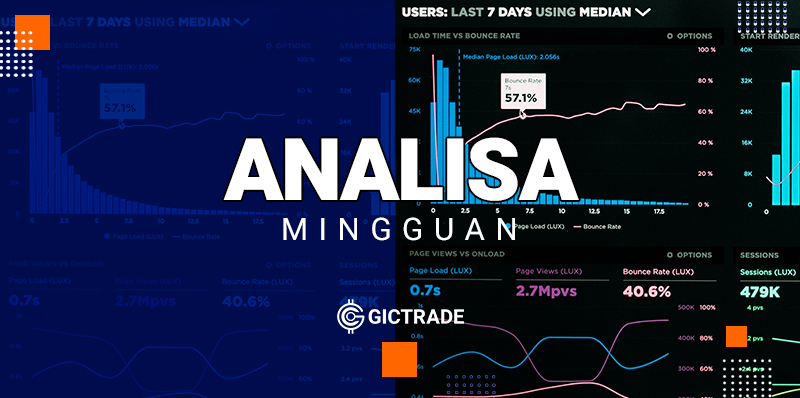This weekly market analysis for February 1-5, 2021 will discuss things that can affect the market during the week, such as the strengthening of the US Dollar getting support from market movements in the Asian session on Monday (February 1, 2021). The strengthening of the US Dollar is due to concerns about the US fiscal stimulus, which is feared not to be as fast and as large as planned by President-elect Joe Biden. The debate over the amount of funds for the Covid-19 fiscal stimulus package planned by President-elect Joe Biden, plus the delay in vaccine distribution, also affected the condition of the US Dollar. Market players are negative and softer in entering the market, due to the turmoil on Wall Street. The very rare stock frying action caused the Dow Jones, Nasdaq, and S&P 500 indices to plunge by 2% last week. Investors choose safer assets by buying US Dollars. For the EURUSD movement, amid positive German and US economic data, the Euro is predicted to strengthen against the US Dollar, due to concerns about the uncertainty of US fiscal stimulus. The movement at the beginning of this week EURUSD is expected to still try to strengthen. The movement of crude oil is expected to increase, due to optimistic signals regarding the cut in crude oil production by Saudi Arabia. In today's Asian trading session, Monday (February 1, 2021), oil prices have the potential to decline, but if concerns increase due to declining fuel purchasing power due to uncertainty over US fiscal stimulus and the increase in Covid-19 cases in the world. Gold prices have increased at the end of last week, supported by physical buying of Gold metal amid easing market concerns about the sell-off of shares of Hedge Fund companies in the US. In early trading this week, Monday in the Asian session (February 1, 2021), Gold is predicted to decline.
1. Important Data/High Impact on Weekly Market Analysis 01 - 05 February 2021
1.1 ISM Manufacturing PMI (USD)
Monday, 22:00 WIB. ISM Manufacturing PMI is the same index released by Market for Manufacturing PMI, but the data is sourced and created by the Institute for Supply Management (ISM) which is specifically created for the US. This indicator will usually have a greater impact than the one released by Market. Just info This index is created based on a survey of around 400 purchasing managers in the US, regarding current business conditions and situations, including production output, product availability, shipping activity, number of orders, and number of workers or employees. If the release is above 50.0 then it reflects expansion in the manufacturing sector, but if it is below 50.0 it indicates contraction.
1.2 RBA Rate Statement (AUD)
Tuesday, 10:30 WIB. The Reserve Bank of Australia (RBA) at its meeting later, plans to maintain interest rates at 0.10%. If the RBA is as predicted above, the Aussie will move to strengthen against the US Dollar if the currency of the superpower country continues to weaken.
1.3 Employment Change & Unemployment Rate (NZD)
Wednesday, 04:45 WIB. This data illustrates the level of employment that can accommodate new workers and the unemployment rate in New Zealand. The unemployment rate in New Zealand in January, if later released is smaller than last month, then unemployment in New Zealand will decrease, and the New Zealand currency will strengthen, and vice versa. As for the addition of new jobs in January, if later released above the previous data, it will strengthen the New Zealand currency.
1.4 Asset Purchase Facility, BOE Monetary Policy Report, MPC Asset Purchase Facility Votes, MPC Official Bank Rate Votes, Monetary Policy Summary & Official Bank Rate (GBP)
Thursday, 19:00 WIB. Asset Purchase Facility is data that will look at the total value of money that will be created and used by the BOE to buy assets in the open market. Where MPC members vote on the total amount of money to be created for the program. Individual votes are published 2 weeks later in the MPC Meeting Minutes. This data is used to increase demand for bonds which usually leads to lower long-term interest rates. The BOE Monetary Policy Report is data that will provide valuable insight into the bank's views on economic conditions and inflation - key factors that will shape the future of monetary policy and influence their interest rate decisions. MPC Asset Purchase Facility Votes are the results of the BOE MPC meeting containing asset purchase votes for each MPC member during the last meeting. The vote details provide insight into which members changed their stance on asset purchases and how close the committee is to enacting changes in future purchases. MPC Official Bank Rate Votes are the results of the BOE MPC meeting containing interest rate votes for each MPC member during the last meeting. The vote details provide insight into which members changed their stance on interest rates and how close the committee is to enacting changes in future interest rates. Monetary Policy Summary This data is one of the main tools the MPC uses to communicate with investors about monetary policy. It contains the results of their votes on interest rates and other policy measures, along with commentary on the economic conditions that influenced their votes. Most importantly, it discusses the economic outlook and offers clues about future vote outcomes. Official Bank Rate Interest rate decisions are usually priced into the market, so they tend to be overshadowed by the forward-focused Monetary Policy Summary. Short-term interest rates are the most important factor in currency valuations - traders look to most other indicators only to predict how interest rates will change in the future. MPC members vote on where to set rates. Individual votes are published 2 weeks later in the MPC Meeting Minutes.
1.5 RBA Gov Lowe Speaks (AUD)
Friday, 5:30 a.m. WIB. As head of the central bank, which controls short-term interest rates, he has more influence over the value of the country's currency than anyone else. Traders watch his public engagements because they are often used to provide subtle hints about future monetary policy.
1.6 Employment Change & Unemployment Rate (CAD)
Friday, 20:30 WIB. Employment Change is important because job creation is an important leading indicator of consumer spending, which accounts for the majority of overall economic activity. This data is an important economic data released shortly after the end of the month. The combination of importance and clarity produces a large and powerful market impact. The Unemployment Rate is the percentage (%) of the total working age population who are unemployed and actively looking for work during the previous month. Although generally viewed as a less solid indicator, the number of unemployed is an important signal of overall economic health because consumer spending is highly correlated with labor market conditions.
1.7 BOE Gov Bailey Speaks (GBP)
Friday, 8:30 p.m. WIB. As head of the central bank, which controls short-term interest rates, he has more influence over the value of the country's currency than anyone else. Traders watch his public engagements because they are often used to provide subtle hints about future monetary policy.
1.8 Average Hourly Earnings, Non-Farm Employment Change & Unemployment Rate (USD)
Friday, 20:30 WIB. Average Hourly Earnings is an indicator of the inflation rate derived from the amount of hourly wages paid by employers outside the agricultural sector. If the value of the Average Hourly Earnings of the United States (US) is good or increases, the US Dollar will strengthen, and vice versa.
Non-Farm Employment Change is data that measures the level of new jobs outside the agricultural sector. What is the relationship between Average Hourly Earnings and Non-Farm Employment Change? NFP data and Average Earnings data are related and influence each other, but NFP data has a greater impact on market movements. Average earnings are the percentage change in hourly wages. If the NFP is good but the Average Hourly Earnings fall, the US Dollar may still strengthen, because there is a prediction that in the following month Earnings will be good followed by an increase in the number of workers. Conversely, if the NFP is bad, the USD will tend to weaken even though Earnings are good.
Unemployment Rate is data that measures the monthly unemployment rate in the US. Last month the unemployment rate was released at 6.7% and is predicted to remain unchanged in January at 6.7%. If it is released below the prediction, the US Dollar will strengthen.
2. Technical Review of Weekly Market Analysis 01 - 05 February 2021
2.1 EUR/USD

| Preference |
BEARISH |
| Movement Range |
1,22247 (High) |
| Movement Range |
1,20478 (Low) |
2.2 USDCHF

| Preference |
BULLISH |
| Movement Range |
0,90490 (High) |
| Movement Range |
0,88248 (Low) |
2.3 GBPUSD

| Preference |
BULLISH |
| Movement Range |
1,39510 (High) |
| Movement Range |
1,36299 (Low) |
2.4 USDJPY

| Preference |
BULLISH |
| Movement Range |
105,668 (High) |
| Movement Range |
103,917 (Low) |
2.5 Gold

| Preference |
BULLISH |
| Movement Range |
1879,00 (High) |
| Movement Range |
1813,00 (Low) |
2.6 AUDUSD

| Preference |
BULLISH |
| Movement Range |
0,77845 (High) |
| Movement Range |
0,75508 (Low) |
2.7 Oil

| Preference |
BULLISH |
| Movement Range |
54,84 (High) |
| Movement Range |
50,35 (Low) |
This is the weekly market analysis for February 1-5, 2021. Always prioritize Money Management and Risk Management in your trading.
Visit GIC Indonesia to get information about the world of
trading. You can also join us in the
Telegram Community GIC Trade and
Telegram Channel GIC Trade. Don't forget to check the
Youtube account GIC Indonesia which is full of lots of information, and follow our
Instagram account to get information about various interesting webinars that you can follow.







 Last:
Last: 







